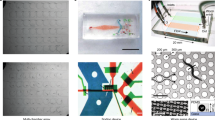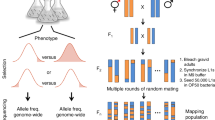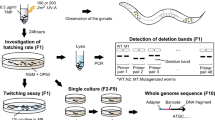Key Points
-
Several major biological discoveries have been made by Caenorhabditis elegans researchers over the years. Today, C. elegans remains one of the most versatile and exciting model organisms to study.
-
Although the extensive palette of tools and resources developed by the C. elegans community greatly facilitates new discoveries, it can also be overwhelming to new worm biologists.
-
Here we discuss the main resources that have been developed for C. elegans research with the aim of helping newcomers to the field in selecting the tools that are best suited to their needs. We also hope that this article will become a useful reference for established C. elegans scientists.
-
We first describe C. elegans online databases and resources that cover topics ranging from worm anatomy to phenotypes and gene function, to information on related nematodes and comparative genomics. They also include tools that allow the retrieval of expression patterns, automated data extraction from the literature, analysis of microarray data, and so on.
-
We then discuss the experimental resources that are available to the C. elegans community, including collections of genomic and cDNA clones, full-genome RNAi libraries, gene-knockout services, repositories of mutant and transposon-tagged strains, reagents for studies of gene function and expression patterns, vector kits for a variety of C. elegans-specific applications, and so on.
-
Although the importance of the existing resources cannot be overestimated, the continual expansion of C. elegans research will require their further improvement, and the development of radically new approaches and tools. We hope that this article will be helpful in identifying new research opportunities and will stimulate the development of additional resources.
Abstract
Since its establishment as a model organism, Caenorhabditis elegans has been an invaluable tool for biological research. An immense spectrum of questions can be addressed using this small nematode, making it one of the most versatile and exciting model organisms. Although the many tools and resources developed by the C. elegans community greatly facilitate new discoveries, they can also overwhelm newcomers to the field. This Review aims to familiarize new worm researchers with the main resources, and help them to select the tools that are best suited for their needs. We also hope that it will be helpful in identifying new research opportunities and will promote the development of additional resources.
This is a preview of subscription content, access via your institution
Access options
Subscribe to this journal
Receive 12 print issues and online access
$189.00 per year
only $15.75 per issue
Buy this article
- Purchase on Springer Link
- Instant access to full article PDF
Prices may be subject to local taxes which are calculated during checkout





Similar content being viewed by others
References
C. elegans Sequencing Consortium. Genome sequence of the nematode C. elegans: a platform for investigating biology. Science 282, 2012–2018 (1998). This cornerstone paper describes the sequencing of the C. elegans genome, the first from a multicellular organism. The project produced the essentially complete catalogue of worm genes, enabling functional and genomic studies. Collaboration between the Sequencing Consortium and the C. elegans research community was essential for cross-correlation of physical and genetic maps, making possible much of the genetic research that relied heavily on positional cloning of mutants identified in genetic screens.
Stein, L. et al. The genome sequence of Caenorhabditis briggsae: a platform for comparative genomics. PLoS Biol. 1, 166–192 (2003).
Wood, W. B. (ed.) The Nematode Caenorhabditis elegans (Cold Spring Harbor Laboratory Press, Cold Spring Harbor, 1988).
Riddle, D. L., Blumenthal, T., Meyer, B. J. & Priess, J. R. (eds) C. Elegans II (Cold Spring Harbor Laboratory Press, Plainview, 1997).
Girard, L. R. et al. WormBook: the online review of Caenorhabditis elegans biology. Nucleic Acids Res. 35, D472–D475 (2006). WormBook provides up-to-date reviews on all aspects of C. elegans biology and the experimental methods that are used to study this organism. The paper describes the goals of the project, the current content of WormBook and its future directions.
Bieri, T. et al. WormBase: new content and better access. Nucleic Acids Res. 35, D506–D510 (2007). The article is the latest instalment in a series of articles that focus on the most recent changes and additions to WormBase. As the primary database for C. elegans and related nematodes, WormBase accumulates comprehensive genetic, genomic and functional information on C. elegans genes and provides links to other databases and resources such as PubMed and Entrez Gene.
Gunsalus, K. C., Yueh, W. C., MacMenamin, P. & Piano, F. RNAiDB and PhenoBlast: web tools for genome-wide phenotypic mapping projects. Nucleic Acids Res. 32, D406–D410 (2004). In-depth studies of the phenotypes that are produced in genome-wide RNAi screens hold great promise for large-scale functional analyses of the genome. RNAiDB exemplifies the controlled-vocabulary-based approach to phenotype description, which enables computational analyses of observed defects, including phenotypic clustering, classification and gene searches involving phenotypic signature similarity.
Sonnichsen, B. et al. Full-genome RNAi profiling of early embryogenesis in Caenorhabditis elegans. Nature 434, 462–469 (2005).
Li, S. et al. A map of the interactome network of the metazoan C. elegans. Science 303, 540–543 (2004). Gene- and protein-interaction networks and their integration with other types of large-scale data sets serve as powerful hypotheses generating tools. This article describes the first attempt to build a protein-interaction network in C. elegans using a high-throughput yeast two-hybrid approach.
Hermjakob, H. et al. IntAct: an open source molecular interaction database. Nucleic Acids Res. 32, D452–D455 (2004).
Stark, C. et al. BioGRID: a general repository for interaction datasets. Nucleic Acids Res. 34, D535–D539 (2006).
Deplancke, B., Dupuy, D., Vidal, M. & Walhout, A. J. A Gateway-compatible yeast one-hybrid system. Genome Res. 14, 2093–2101 (2004).
Barrasa, M. I., Vaglio, P., Cavasino, F., Jacotot, L. & Walhout, A. J. EDGEdb: a transcription factor–DNA interaction database for the analysis of C. elegans differential gene expression. BMC Genomics 8, 21 (2007).
Maeda, I., Kohara, Y., Yamamoto, M. & Sugimoto, A. Large-scale analysis of gene function in Caenorhabditis elegans by high-throughput RNAi. Curr. Biol. 11, 171–176 (2001).
Mounsey, A., Bauer, P. & Hope, I. A. Evidence suggesting that a fifth of annotated Caenorhabditis elegans genes may be pseudogenes. Genome Res. 12, 770–775 (2002).
Hope, I. A. et al. Feasibility of genome-scale construction of promoter::reporter gene fusions for expression in Caenorhabditis elegans using a multisite Gateway recombination system. Genome Res. 14, 2070–2075 (2004).
Ball, C. A. et al. The Stanford Microarray Database accommodates additional microarray platforms and data formats. Nucleic Acids Res. 33, D580–D582 (2005).
Kim, S. K. et al. A gene expression map for Caenorhabditis elegans. Science 293, 2087–2092 (2001).
Stuart, J. M., Segal, E., Koller, D. & Kim, S. K. A gene-coexpression network for global discovery of conserved genetic modules. Science 302, 249–255 (2003).
Barrett, T. et al. NCBI GEO: mining millions of expression profiles — database and tools. Nucleic Acids Res. 33, D562–D566 (2005).
Parkinson, H. et al. ArrayExpress — a public repository for microarray gene expression data at the EBI. Nucleic Acids Res. 33, D553–D555 (2005).
Kapushesky, M. et al. Expression Profiler: next generation — an online platform for analysis of microarray data. Nucleic Acids Res. 32, W465–W470 (2004).
Jones, S. J. et al. Changes in gene expression associated with developmental arrest and longevity in Caenorhabditis elegans. Genome Res. 11, 1346–1352 (2001).
McKay, S. J. et al. Gene expression profiling of cells, tissues, and developmental stages of the nematode C. elegans. Cold Spring Harb. Symp. Quant. Biol. 68, 159–169 (2003).
Halaschek-Wiener, J. et al. Analysis of long-lived C. elegans daf-2 mutants using serial analysis of gene expression. Genome Res. 15, 603–615 (2005).
Luan, C. H. et al. High-throughput expression of C. elegans proteins. Genome Res. 14, 2102–2110 (2004).
Berman, H. M. et al. The Protein Data Bank. Nucleic Acids Res. 28, 235–242 (2000).
Muller, H. M., Kenny, E. E. & Sternberg, P. W. Textpresso: an ontology-based information retrieval and extraction system for biological literature. PLoS Biol. 2, e309 (2004). Textpresso is a full-text literature search platform that was developed specifically for C. elegans research. This paper outlines the logic behind its powerful ontology-based search engine and discusses new possibilities that are offered by the system.
Sommer, R. J. As good as they get: cells in nematode vulva development and evolution. Curr. Opin. Cell Biol. 13, 715–720 (2001).
Mitreva, M. & Jasmer, D. P. Biology and genome of Trichinella spiralis in WormBook (ed. The C. elegans Research Community) 23 Nov 2006 (doi: 10.1895/wormbook.1.124.1).
Robert, V. & Bessereau, J. L. Targeted engineering of the Caenorhabditis elegans genome following Mos1-triggered chromosomal breaks. EMBO J. 26, 170–183 (2007).
Walhout, A. J. et al. Gateway recombinational cloning: application to the cloning of large numbers of open reading frames or ORFeomes. Methods Enzymol. 328, 575–592 (2000).
Lamesch, P. et al. C. elegans ORFeome version 3. 1: increasing the coverage of ORFeome resources with improved gene predictions. Genome Res. 14, 2064–2069 (2004).
Dupuy, D. et al. A first version of the Caenorhabditis elegans Promoterome. Genome Res. 14, 2169–2175 (2004).
Timmons, L. Delivery methods for RNA interference in C. elegans. Methods Mol. Biol. 351, 119–125 (2006).
Reinke, V. et al. A global profile of germline gene expression in C. elegans. Mol. Cell 6, 605–616 (2000). Microarray analyses have become an essential part of biological research. The first C. elegans microarray-based expression-profiling study, which paved the way for many functional studies in C. elegans , is presented in this paper.
Jiang, M. et al. Genome-wide analysis of developmental and sex-regulated gene expression profiles in Caenorhabditis elegans. Proc. Natl Acad. Sci. USA 98, 218–223 (2001).
Praitis, V., Casey, E., Collar, D. & Austin, J. Creation of low-copy integrated transgenic lines in Caenorhabditis elegans. Genetics 157, 1217–1226 (2001).
Piano, F. et al. Gene clustering based on RNAi phenotypes of ovary-enriched genes in C. elegans. Curr. Biol. 12, 1959–1964 (2002).
Alexeyenko, A., Tamas, I., Liu, G. & Sonnhammer, E. L. Automatic clustering of orthologs and inparalogs shared by multiple proteomes. Bioinformatics 22, e9–e15 (2006).
Husson, S. J., Clynen, E., Baggerman, G., De Loof, A. & Schoofs, L. Discovering neuropeptides in Caenorhabditis elegans by two dimensional liquid chromatography and mass spectrometry. Biochem. Biophys. Res. Commun. 335, 76–86 (2005).
Wielsch, N. et al. Rapid validation of protein identifications with the borderline statistical confidence via de novo sequencing and MS BLAST searches. J. Proteome Res. 5, 2448–2456 (2006).
Maglott, D., Ostell, J., Pruitt, K. D. & Tatusova, T. Entrez Gene: gene-centered information at NCBI. Nucleic Acids Res. 33, D54–D58 (2005).
Hubbard, T. et al. Ensembl 2005. Nucleic Acids Res. 33, D447–D453 (2005).
Karolchik, D. et al. The UCSC Genome Browser Database. Nucleic Acids Res. 31, 51–54 (2003).
Kent, W. J. & Zahler, A. M. Conservation, regulation, synteny, and introns in a large-scale C. briggsae–C. elegans genomic alignment. Genome Res. 10, 1115–1125 (2000).
Schwartz, S. et al. Human–mouse alignments with BLASTZ. Genome Res. 13, 103–107 (2003).
Jurka, J. Repbase update: a database and an electronic journal of repetitive elements. Trends Genet. 16, 418–420 (2000).
Kent, W. J. et al. Exploring relationships and mining data with the UCSC Gene Sorter. Genome Res. 15, 737–741 (2005).
Bairoch, A. et al. The Universal Protein Resource (UniProt). Nucleic Acids Res. 33, D154–D159 (2005).
O'Brien, K. P., Remm, M. & Sonnhammer, E. L. Inparanoid: a comprehensive database of eukaryotic orthologs. Nucleic Acids Res. 33, D476–D480 (2005).
Chen, F., Mackey, A. J., Stoeckert, C. J. Jr & Roos, D. S. OrthoMCL-DB: querying a comprehensive multi-species collection of ortholog groups. Nucleic Acids Res. 34, D363–D368 (2006).
Li, H. et al. TreeFam: a curated database of phylogenetic trees of animal gene families. Nucleic Acids Res. 34, D572–D580 (2006).
Joshi-Tope, G. et al. Reactome: a knowledgebase of biological pathways. Nucleic Acids Res. 33, D428–D432 (2005).
Krieger, C. J. et al. MetaCyc: a multiorganism database of metabolic pathways and enzymes. Nucleic Acids Res. 32, D438–D442 (2004).
Kanehisa, M., Goto, S., Kawashima, S., Okuno, Y. & Hattori, M. The KEGG resource for deciphering the genome. Nucleic Acids Res. 32, D277–D280 (2004).
Lemer, C. et al. The aMAZE LightBench: a web interface to a relational database of cellular processes. Nucleic Acids Res. 32, D443–D448 (2004).
Ashburner, M. et al. Gene ontology: tool for the unification of biology. The Gene Ontology Consortium. Nature Genet. 25, 25–29 (2000).
Bateman, A. et al. The Pfam protein families database. Nucleic Acids Res. 32, D138–D141 (2004).
Finn, R. D. et al. Pfam: clans, web tools and services. Nucleic Acids Res. 34, D247–D251 (2006).
Griffiths-Jones, S. et al. Rfam: annotating non-coding RNAs in complete genomes. Nucleic Acids Res. 33, D121–D124 (2005).
Griffiths-Jones, S., Grocock, R. J., van Dongen, S., Bateman, A. & Enright, A. J. miRBase: microRNA sequences, targets and gene nomenclature. Nucleic Acids Res. 34, D140–D144 (2006).
Reinhart, B. J. et al. The 21-nucleotide let-7 RNA regulates developmental timing in Caenorhabditis elegans. Nature 403, 901–906 (2000).
Lee, R. C., Feinbaum, R. L. & Ambros, V. The C. elegans heterochronic gene lin-4 encodes small RNAs with antisense complementarity to lin-14. Cell 75, 843–854 (1993).
Wightman, B., Ha, I. & Ruvkun, G. Posttranscriptional regulation of the heterochronic gene lin-14 by lin-4 mediates temporal pattern formation in C. elegans. Cell 75, 855–862 (1993).
Lau, N. C., Lim, L. P., Weinstein, E. G. & Bartel, D. P. An abundant class of tiny RNAs with probable regulatory roles in Caenorhabditis elegans. Science 294, 858–862 (2001).
Acknowledgements
We thank G. Schindelman for helpful discussions and assistance. I.A. is supported by a grant to WormBase from the US National Human Genome Research Institute (P41-HG02223). P.W.S. is an investigator with the Howard Hughes Medical Institute, Pasadena, USA.
Author information
Authors and Affiliations
Corresponding author
Ethics declarations
Competing interests
The authors declare no competing financial interests.
Glossary
- Controlled vocabulary
-
In contrast to natural language vocabularies, which have no restrictions on the terms that can be used, controlled vocabulary is a set of predefined, authorized terms that have been chosen by its designer to reduce the inherent ambiguity in human language and ensure consistency of concept descriptions.
- Gateway recombinational cloning
-
Gateway cloning technology is based on the site-specific recombination system of λ phage, which allows rapid transfer of DNA fragments between different vectors while maintaining the correct orientation and reading frame. It provides a highly efficient alternative to the restriction-enzyme and ligase-based cloning strategy.
- Expression topomap
-
Expression topomap is a visualization of genes that show correlated expression across a large set of microarray experiments. Co-regulated genes appear as mountains, the height of which indicates local gene density. Expression topomap can be used to infer gene functions or to identify genes that are co-regulated with known sets of genes.
- Ontology
-
Like controlled vocabularies, ontologies, as used in computer science, describe objects using predefined terms. In addition, ontologies define relationships between objects, making it possible to capture the structure of a set of objects.
- Synthetic phenotype
-
A phenotype that is produced when two or more mutations that have no discernable phenotypes on their own are combined.
- MosTIC
-
(Mos1 excision-induced transgene-instructed gene conversion). In MosTIC experiments, a double-strand break (DSB) is introduced by excision of the Mos1 transposable element, which is then repaired using a transgene containing sequences that are homologous to the DSB flanking regions as a template. Modifications that are present in the transgene are incorporated into the genome to enable efficient genome engineering.
- Comparative genomic hybridization
-
Comparative genomic hybridization measures differences in DNA copy numbers between two genomes, usually between a reference and a sample genome. This method can be used to detect deletions, duplications and translocations, and to map associated breakpoints with unprecedented precision and speed.
- ChIP-on-Chip
-
ChIP-on-Chip combines chromatin immunoprecipitation (ChIP) with microarray analysis, most commonly using uniform tiling arrays that cover the whole genome or chips that focus on known promoter regions. ChIP-on-Chip allows the rapid identification of binding sites of DNA-binding proteins, such as transcription factors and histones.
- Smg-dependent control of gene expression
-
mRNAs containing premature stop codons are rapidly degraded by the nonsense-mediated decay pathway, which in C. elegans is represented by members of the Smg gene family. This makes it possible to control the expression of transgenes carrying aberrant 3′ UTRs by regulating the Smg-pathway activity, for example, by using a temperature-sensitive allele of smg-1.
- Polony-based DNA sequencing
-
Polonies (polymerase colonies) are created either on a surface such as a slide or gel, or in emulsion attached to beads. PCR within each polony produces clusters that contain millions of template copies, which grow like bacterial colonies. The amplified template can then be sequenced by synthesis or ligation in a highly parallel fashion, enabling high-throughput genome sequencing.
Rights and permissions
About this article
Cite this article
Antoshechkin, I., Sternberg, P. The versatile worm: genetic and genomic resources for Caenorhabditis elegans research. Nat Rev Genet 8, 518–532 (2007). https://doi.org/10.1038/nrg2105
Published:
Issue Date:
DOI: https://doi.org/10.1038/nrg2105
This article is cited by
-
Automated recognition and analysis of body bending behavior in C. elegans
BMC Bioinformatics (2023)
-
An economical and highly adaptable optogenetics system for individual and population-level manipulation of Caenorhabditis elegans
BMC Biology (2021)
-
Assessing motor-related phenotypes of Caenorhabditis elegans with the wide field-of-view nematode tracking platform
Nature Protocols (2020)
-
Biology and genome of a newly discovered sibling species of Caenorhabditis elegans
Nature Communications (2018)
-
Targeted genome engineering in Caenorhabditis elegans
Cell & Bioscience (2016)



